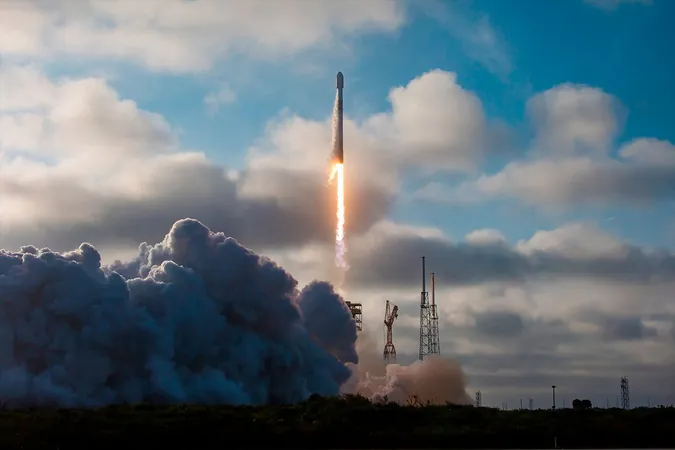
Catching the Cosmic Countdown: How to Anticipate a Supernova Explosion and Why It Matters
2024-12-12
Author: Benjamin
Catching the Cosmic Countdown: How to Anticipate a Supernova Explosion and Why It Matters
Stars are not just points of light in our sky; they are dynamic systems with life cycles that reach extraordinary conclusions. The death of a star culminates in one of the universe’s most magnificent spectacles—the supernova explosion. Much like a campfire needs fuel to keep burning, a star primarily uses hydrogen for nuclear fusion, producing the energy necessary to resist the immense inward pull of its gravity.
When a star exhausts its hydrogen supply, the outward force disappears. Without balance, the star begins to collapse under its own gravitational weight, accelerating toward its core at nearly the speed of light. The core then rebounds, resulting in a cataclysmic explosion that scatters stellar remnants across the cosmos at speeds that outpace even the fastest rockets ever created.
For astronomers, one of the prime objectives is to deduce the different types of stars responsible for varying explosion phenomena. Do larger stars inevitably produce brighter detonations? How does the surrounding environment, filled with dust and gas, influence the nature of these explosions?
Although we have computer models simulating stellar deaths, validating these models remains tricky. To truly grasp what leads to a supernova, witnessing a star’s behavior in real-time just before its demise could provide invaluable data—but doing so is no small feat.
Comparatively, scientists often predict volcanic eruptions by closely monitoring precursors, just as volcanologists in 1980 did with Mount St. Helens. As unrest built within the volcano, phenomena such as tremors and steam explosions hinted at the forthcoming eruption, which would eventually lead to a devastating landslide and eruption.
Pre-Supernova Signs: A Cosmic Parallel
Massive stars, which are generally greater than ten times the mass of our sun, exhibit pre-supernova behavior at a grand scale. A notable example is SN 2009ip, a stellar event observed in 2009 from a distance of 65 million light-years. Initially classified as a supernova explosion, it was soon deemed a “supernova impostor” due to its unexpected dimming and lack of complete destruction.
Between 2009 and 2012, SN 2009ip presented multiple brightness fluctuations that resembled flickers from an intermittent light bulb, ultimately culminating in an actual supernova event. The details surrounding this protracted behavior remain a tantalizing mystery for astrophysics.
Recently, in a groundbreaking discovery published in *Astronomy and Astrophysics*, our research team identified a peculiar star in the Virgo Cluster—also 65 million light-years away. Unlike SN 2009ip, this star primarily comprises helium and exhibited a gradual increase in brightness over five years, reminiscent of slowly dimming up a light. The supernova that followed, designated SN 2023fyq, allowed astronomers worldwide to observe the first light from the explosion due to heightened monitoring of its predecessor’s activity.
Challenging Existing Theories
This precursor activity opens a rare window into the mechanics behind supernovae, but it also raises new questions about our existing theoretical frameworks. While isolated massive stars typically do not demonstrate such rapid bursts of brightness, it is theorized that in their final moments, they’re desperately attempting to fend off gravitational collapse with dwindling resources.
The observations suggest that interactions with nearby stars may play a critical role in these phenomena. In stellar nurseries, where dense gas and dust clouds give rise to multiple stars, gravitational relationships may result in mass transfer between stars, which could help explain the brightness fluctuations seen in events like SN 2009ip and the helium-rich nature of SN 2023fyq.
Compellingly, not all colossal eruptions lead to supernovae. The famous “Great Eruption” of Eta Carinae in the 1840s resulted in the expulsion of vast amounts of material into space without the star meeting its end.
The Future of Supernova Research
As we probe the depths of these cosmic events, the unveiling of precursor activities could revolutionize our understanding of stellar deaths. Upcoming advancements, such as the Vera C. Rubin Observatory set to launch in 2025, promise groundbreaking observations with its incredible 3,200-megapixel camera. This device is anticipated to be drastically more sensitive than current technology, enabling astronomers to explore fainter pre-explosive signals.
At Stockholm University, our team is making use of advanced telescopes—including the Nordic Optical Telescope and the Very Large Telescope—to track the telltale signs of imminent stellar demise. As we enhance our capability to detect these signals, we aim to create a proactive scientific community prepared to witness and analyze a star's spectacular final act.
By unearthing the mysteries surrounding supernovae, we expand not just our understanding of these cosmic explosions but also of the universe itself—gaining insights into stellar life cycles and the evolution of galaxies. The quest to catch a supernova explosion before it happens continues, promising revelations that could reshape our cosmic narrative.









 Brasil (PT)
Brasil (PT)
 Canada (EN)
Canada (EN)
 Chile (ES)
Chile (ES)
 España (ES)
España (ES)
 France (FR)
France (FR)
 Hong Kong (EN)
Hong Kong (EN)
 Italia (IT)
Italia (IT)
 日本 (JA)
日本 (JA)
 Magyarország (HU)
Magyarország (HU)
 Norge (NO)
Norge (NO)
 Polska (PL)
Polska (PL)
 Schweiz (DE)
Schweiz (DE)
 Singapore (EN)
Singapore (EN)
 Sverige (SV)
Sverige (SV)
 Suomi (FI)
Suomi (FI)
 Türkiye (TR)
Türkiye (TR)